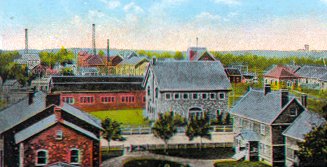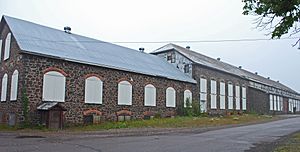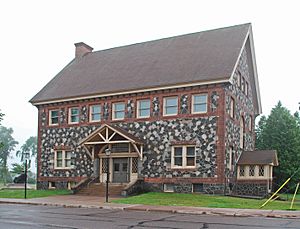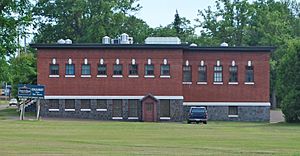Calumet and Hecla Industrial District facts for kids
|
Calumet and Hecla Industrial District
|
|
|
U.S. Historic district
Contributing property |
|

Calumet & Hecla Industrial Site, c. 1910. Library is in the middleground at center.
|
|
| Location | Roughly bounded by Hecla and Torch Lake RR tracks, Calumet Ave., Mine and Depot Sts., Calumet, Michigan |
|---|---|
| Architect | Shaw & Hunnewell; Et al. |
| Part of | Calumet Historic District (ID89001097) |
| NRHP reference No. | 74000985 |
Quick facts for kids Significant dates |
|
| Added to NRHP | June 28, 1974 |
| Designated CP | March 28, 1989 |
The Calumet and Hecla Industrial District is a special historical area in Calumet, Michigan. It's a collection of old buildings and structures that were once part of the famous Calumet and Hecla Mining Company. This company was a huge player in copper mining.
The district is located near old railroad tracks and streets like Calumet Avenue and Mine Street. It's also part of a larger historical area called the Calumet Historic District and the Keweenaw National Historical Park. This district was recognized as a Michigan State Historic Site in 1973 and added to the National Register of Historic Places in 1974.
Contents
What is the History of the Calumet and Hecla Industrial District?
The rich copper deposits under this area were found in 1858 by Edwin J. Hulbert. He quickly got people to invest money, bought the land, and started the Hulbert Mining Company. This company had two smaller parts: the Calumet Mining Company and the Hecla Mining Company.
Hulbert started mining, but he wasn't very experienced. Because of this, they didn't find much copper at first. In 1867, the investors decided to replace him with Alexander Agassiz.
Under Agassiz's leadership, the Calumet and Hecla mines became very successful. They quickly produced much more copper. By 1870, these mines were digging up more than half of all the copper in the United States! In 1871, the Calumet and Hecla Mining Companies joined together. They also combined with two other companies to form the big Calumet and Hecla Mining Company.
Agassiz became the president of this new company. He stayed in charge until he passed away in 1910. The company did very well under him. Many of the buildings you can see in the district today were built between 1880 and 1910.
However, after a big mining strike in 1913, the company slowly started to struggle. The Great Depression in the 1930s made things even worse. Finally, in 1968, another company bought Calumet and Hecla. They then closed the mines in the Keweenaw area for good.
What Buildings Are in the District?
There are ten important buildings in this historic district. They include the Machine Shop, the "Blacksmith Shop" (which was actually a Pipe Shop), the Roundhouse, Warehouse #2, the Superior Boilerhouse, the Gearhouse, the General Office Building, the Library, the Bathhouse, and the Miscowaubik Club.
Most of these buildings were built in the 1880s. They were the second set of mine buildings on this site. The very first buildings were either burned down or taken apart. These buildings are part of a larger group of industrial structures. They were all built by the Calumet and Hecla Mining Company and are still standing today.
Machine Shop (around 1882)
The Machine Shop is a large, two-story building. It is about 416 feet (127 m) long and 54 feet (16 m) wide. It's made from rough mine rock with a special roof covered in metal. There are windows high up to let light inside. The floor is made of concrete.
This shop was first designed around 1882. It was used to fix very large equipment, like the carts used to carry ore out of the mines. The building was largely rebuilt in 1907 and had more parts added in 1911. So, the building you see today mostly dates from those years.
Blacksmith Shop (Pipe Shop) (1883)
The Blacksmith Shop was built in 1883. It has a sloped roof and is made of rock. It measures about 96 feet (29 m) by 54 feet and has a metal roof.
This building was first used to store locomotives for the Calumet & Hecla railroad. Later, it became a smith shop, where metal was shaped and repaired. An extra part was added to it in 1904.
Roundhouse (1888)
The Roundhouse is a unique building made of mine rock. It's shaped like a half-circle with a spinning platform (a turntable) in the middle. It was built in 1888 to service the locomotives (trains) used by the Hecla and Torch Lake Railroad.
The original building went about 170 degrees around the turntable. It had twelve train stalls, which were like garages for the trains. These stalls were between 75 feet (23 m) and 90 feet (27 m) deep. The building has brick arches over its windows.
In 1902, more sections were added, making the building even larger. In 1907, three more parts were built: a small shed, a drying house, and a 75 feet (23 m) by 60 feet (18 m) machine shop. Finally, in 1928, an 80 feet (24 m) by 37 feet (11 m) storage area was added.
Warehouse #2
Warehouse number 2 was built with train tracks running right through it. This design made it easy to load very large items directly onto trains inside the building.
Superior Boilerhouse (1880)
The original Superior Boilerhouse was built in 1880. It's a 60 feet (18 m) by 77 feet (23 m) building made of rough stone. It has a very steep roof and a tall brick smokestack that is about 150 feet (46 m) high.
In 1895, a new section called the "New Boilerhouse" was added. It measures 154 feet (47 m) by 69 feet. Both parts of the boilerhouse were designed to create steam. This steam was then sent to a nearby enginehouse to power machinery.
Gearhouse (around 1890)
The Gearhouse is built from rough sandstone and mine rock. It has a steeply sloped roof and measures about 78 feet (24 m) by 71 feet (22 m).
This building was first constructed in the 1880s. However, it had to be rebuilt in the 1890s after a big fire. Originally, it held the main pumping engine equipment. But in 1892, it was changed into an electrical power house. It was used for this purpose until a new power plant was built in Lake Linden in 1906.
General Office Building (around 1890)
The General Office Building is a large, three-and-a-half-story building. It's made of reddish-brown stone with brick details. This building was the main center for managing the mine's operations. It also housed the engineering and accounting departments.
The first part of the building was designed in the early 1890s. Later, two more sections were added that matched the original style. Today, this building serves as the main office for the Keweenaw National Historical Park.
Library (1898)
The Library building was also designed by the same architects as the office building. It is two-and-a-half stories tall. It's built from rough stone with brick around the windows. The building has a "T" shape. Its roof is made of dark grey slate.
When it was first built, the library had reading rooms for adults and children on the second floor. The first floor had library shelves, offices, and cloakrooms. The basement even had baths for men, women, and children! Over the years, some small changes were made, like adding an entrance porch.
In 1911, a new bathhouse was built, so the library's bath section was changed to hold more books. As the Calumet & Hecla Mining Company faced harder times, it became difficult to support the library. In 1944, the library's books were moved to Calumet High School. The building was then used for offices.
Today, the library building is the Keweenaw History Center. It holds historical items and old records. This library is important because it shows how companies sometimes provided services for their workers back then. It's also a great example of beautiful design and stonework.
Bathhouse (1910)
The Bathhouse was built in 1910. It provided bathing facilities for the miners. In November 2020, a company called Calumet Electronics bought the building. They plan to renovate it and use it as their main office.
Miscowaubik Club (around 1875)
The Miscowaubik Club building was first built as a private home. It's believed to have been built around 1875 for Thomas Hoatson, who was the chief mining engineer.
This house is two-and-a-half stories tall and made of wood. It measures about 108 feet (33 m) by 83 feet. In 1903, the house was turned into a private club. The building has been changed quite a bit inside and out over the years.









